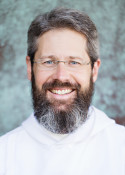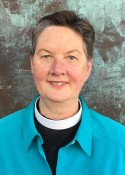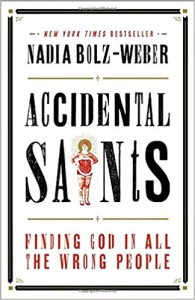From the Rector
 You Know It’s a Compromise…
You Know It’s a Compromise…
Many years ago I remember hearing a friend of mine explain what a compromise is to his 13 year old son. “You know it’s a compromise,” my friend counseled, “when both sides are unhappy with the result.” It may not be surprising to hear that his son was not particularly pleased with this definition (or the decision that preceded his question).
This came to mind this week with the passage of legislation at our every-three-year General Convention being held in Austin, Texas. Titled B012, it aimed to resolve a problem that currently exists in our church. Up to this point, the rites of marriage for all couples weren’t available in all dioceses. If the bishop of a diocese was not in support of same-sex marriage, then they could forbid congregations from using the rites. Couples could (and have) travel to other dioceses in order to be married but could not be married in their home church. This has been the source of pain and frustration.
At the same time, there are many who have wanted to change the Book of Common Prayer’s language in the marriage to be gender neutral. For several years we have been at an impasse about these issues. This legislation, then, sought to bridge the impasse. It pushes gender neutral language to a future convention, and allows another bishop to engage in oversight with a congregation that wishes to celebrate a same-sex wedding of a couple. This compromise permits a bishop who has theological difference with same-sex blessing to momentarily allow for the pastoral episcopal oversight of another bishop, so that the Vicar or Rector can perform the sacramental rite.
As you might imagine, this compromise, enacted in a time when our politics seem to be at a constant-near-boil, was challenging for some on different sides of the issue. It was neatly summed up in a tweet by the Rev. Susan Russell this past week when she wrote, “You know it’s a compromise when your inbox is blowing up with folks from both edges of the aisle telling you you’re ruining the church. #GC#79 #WelcomeToMyWorld.”
In an era when we have more fully lived into Alexis de Tocqueville’s prescient observation from 1835, “On Democracy in America,” in which he witnessed the capacity of the “tyranny of the majority”, it is rare when a compromise is achieved. Toqueville argued that while the United States had abolished the tyranny of monarchy, depending on how democracy was enacted, a simple majority––unwilling to compromise––could be just as tyrannous.
That’s part of why this compromise from the Episcopal General Convention was so startling in some ways, because of how rarely we have experienced compromise recently in this country. The winner-take-all element is always present in politics, but the events and reactions of the past 18 to 25 years has made the “art of the possible” increasingly seem quaint. But that’s not what emerged in Austin this week.
This is how the Rev. Susan Russell articulated the challenge and possibility on the floor of the House of Deputies this past week,
“Make no mistake about it: these are costly compromises that comes with very real pain. Pain for those who will experience this action as falling short of the full and equal claim for the LGBTQ baptized we have been striving for since 1976. And pain for those who will experience this action as a bridge too far away from their belief that marriage is only between a man and a woman.
The question for this General Convention will be whether the gift of walking together forward into God’s future as members of the Episcopal branch of the Jesus Movement is worth the painful compromises we are mutually being asked to bear in order to make that possible.”
For the an overwhelming number of one body at General Convention the answer was yes ––in the House of Deputies the vote by orders was Clergy: 96 yes, 10 no, 4 divided; Lay: 97 yes, 8 no, 5 divided. And yet, what we witnessed yet again is that is hard to walk together across great difference. Most families can attest to that. But even at times like these––especially in times like these––that may be just what is required.
Peace,
Phil+
From the Associate For Music
On the “beauty of holiness”
 Dealing with music and its meanings often involves dealing with the notion of beauty. This has been a historically tricky subject, especially in the wake of influential thinkers, like the nineteenth-century critic Eduard Hanslick, who have described beauty in universalized ways: “The beautiful is and remains beautiful, even when it generates no feelings, even if it is neither seen nor considered.” This sort of rhetoric drives cultural historians, anthropologists, and others up the wall, but I was recently inspired to put my own kind of pressure on Hanslick’s thinking when I recently began contemplating the psalmist’s call to “worship the Lord in the beauty of holiness,” particularly those famous last three words.
Dealing with music and its meanings often involves dealing with the notion of beauty. This has been a historically tricky subject, especially in the wake of influential thinkers, like the nineteenth-century critic Eduard Hanslick, who have described beauty in universalized ways: “The beautiful is and remains beautiful, even when it generates no feelings, even if it is neither seen nor considered.” This sort of rhetoric drives cultural historians, anthropologists, and others up the wall, but I was recently inspired to put my own kind of pressure on Hanslick’s thinking when I recently began contemplating the psalmist’s call to “worship the Lord in the beauty of holiness,” particularly those famous last three words.
The phrasing “beauty of holiness” originated in a 1535 translation of the Bible by Miles Coverdale, and has endured because in the 1540s Coverdale’s translation of the psalms became the basis for the prose psalter that accompanied the Book of Common Prayer. The words have come up often in my own scholarly work, which focuses on music and religious discourse in England during the reigns of Elizabeth I (1559-1603), James I (1603-1625), and Charles I (1625-1649). Under the last of these monarchs, an increasingly influential group of church officials and other members of the clergy, led by Archbishop of Canterbury William Laud, advanced the cause of more elaborate, and nationally uniform, worship. (Uniformity was already required by law, but had not previously been enforced with such zeal). Their platform included a range of material and performative enrichments to church buildings and to the rituals conducted within them: replacing wooden communion tables with east-facing stone altars, erecting sumptuously decorated baptismal fonts, and emphasizing liturgical gestures that had been criticized as idolatrous and “popish” (a derisive term for Catholic) by some English protestants.
The Laudians, as historians call them, articulated clear rationales for these changes, citing especially the scriptural injunction to “Worship the Lord in the beauty of holiness.” They believed that because churches were houses of God, anyone should be able to, as one writer put it, “behold his [God’s] glory and majesty in the stateliness and beauty of the building, in the richness of the sacred vessels and ornaments, the numerous multitudes of his servants, the various fruits of the blessed sacraments, the dignity, holiness and sacred pomp of his ministers.” It is important to acknowledge that this understanding of scripture did do a certain kind of justice to the original Hebrew word behind Coverdale’s “beauty”: hadarah. This word is glossed in one standard modern lexicon as “holy adornment, always in connection with public worship.” Understood as interested in “adornment” (presently a more descriptive, less evaluative term than “beauty”), the Laudians were straightforwardly following scripture. This is plain enough in the ways they described the function of liturgical ornament: conveying God’s glory and majesty through material and gesture was as much a matter of propriety as of the aesthetic pleasure we tend to associate with “beauty.”
But do exquisite vestments, incense, art, or pageantry trace the only possible path toward the “beauty of holiness?” Those who answer “yes” should (continue to) seek those things out. I’m more interested in the logics of “no.” I can articulate at least three such logics, two of which might strike some readers as obvious or facile (as if this made them less valid). First, beauty might for some people in some contexts be found precisely through the absence of ornament; ornament can become encumbrance, making beauty a product of simplicity. Second, a sort of anthropological response is that elaborateness is easily found in material forms that don’t quite fit High Church stereotypes of neo-Gothic architecture, fancy robes, smells and bells, and Renaissance polyphony (an aesthetic that, being to some extent a product of the nineteenth century, would not have been entirely familiar even to previous groups whose agenda was superficially similar, such as the Laudians); to stick with music for now, the challenging rhythms and complex harmonic vocabulary of contemporary Gospel music surely contribute to any “beauty of holiness” defined by intricacy.
Yet I think an even more interesting way of answering the question I posed would be to accept the sense of beauty as propriety while reframing the notion of ornament. One could argue that worship can or should be adorned not materially but spiritually, decorated with unselfish love for one another and earnest reverence for divine presence. This kind of interpretive turn is not new in protestant exegesis: musical practice has been one of its primary targets, with some evangelical writers opting for metaphorical, rather than literal, readings of scriptural exhortations to sing and make music to God. But it’s hard for me to see the downside in entertaining alternative understandings of beauty and decoration, particularly if this means renewing a commitment to adorn worship with a posture of charity and piety.
Middle School Immersion Trip
Food Justice and Eucharist
 The middle school immersion trip was a big success this year. My primary goal for this trip (now our third year participating in it) was to find some way to bridge the two sometimes disparate topics of Food Justice and the Eucharist. And by George, I think we did it!
The middle school immersion trip was a big success this year. My primary goal for this trip (now our third year participating in it) was to find some way to bridge the two sometimes disparate topics of Food Justice and the Eucharist. And by George, I think we did it!
Throughout the week, we visited Monument Crisis Center in Concord, Planting Justice in Oakland, the Food Pantry at St. Gregory of Nyssa Episcopal Church in San Francisco and more. We talked through the stories of the Feeding of the 5000, the Plentiful Harvest but the few Laborers, the Rich Man and Lazarus and we gave ourselves over the the question, what does any of this have to do with The Purpose Of Christianity. Why are we here and why are we doing all of this? Why is the church visiting all of these places and why do we say the Eucharist every single Sunday.
As it turns out, the answer to the one is found in the other and vice versa. The Eucharist on its own (to nobody’s surprise) doesn’t really make a lot of sense to pre-teens (and I can’t imagine it makes a lot of sense to grown-ups then either). Some folks even really fight the urge to ‘explain’ it by saying that it is totally unknowable — which also isn’t an answer that middle schoolers will buy. Of course you can’t explain it in its fullness, but there are visible and tangible signs of its work in our lives and we can at least try to give it some nice adjectives, if only in-context.
On the other hand, food justice work — what we defined as making sure that everybody has the food that they need — is tricky work on its own. Of course, of course, many folks have a deep and tacit understanding that it’s right and good to feed people. But what is the foundational belief that drives it? When folks have different values (or no stated values) around why feeding people matters, then it’s easy to disagree on method and audience and funding and all the other things that kneecap the non-profit industrial complex and sometimes even cause in-fighting in the Church? Who deserves to be fed, and how much, and how often, and what kind of food exactly? These are the questions people face when there are boards of directors and budget lines and more clients than anybody expected and that without adequate philosophical and theological underpinning are… hard to answer.
So we had to ask the question this week: what does the work of food justice in food pantries and urban gardens tell us about our own Eucharistic tradition? And so what does scripture tell us about the non-profit world’s efforts and motivations to make sure that everybody has enough to eat? And so then, what does it mean for us to be Christians and citizens who’re wrestling with all of these questions?
At the end of the week, each youth was asked to prepare a brief statement along the lines of
“What [the Eucharist or being in communion with God and my neighbor] means to me is______________________________________ because ________________________________ and so my call then as a Christian is ____________________________________.”
We heard some bomb dot com statements and honestly, I couldn’t be more proud of these kiddos and all of their brave and diligent work. I am once again reminded that the Middle School Immersion Trip is the most radical, intense, and holy trip that I get to be a part of every year and I’m so grateful for it.
Faithfully, always,
Ethan
Ethan Lowery is a seminarian at CDSP and a postulant in the Diocese of California, sponsored by All Souls. He is also the youth minister at St. Stephen’s in Orinda, one of All Souls’ ministry partners in the annual Middle School Immersion Trip.
Interfaith Immigration Vigil
Progress, Not Perfection
 As you may have heard this week, there is cause for much celebration. When the Sheriff of Contra Costa County announced that they will cancel their contract to house ICE detainees, he specifically named community based protests as one of the reasons for their decision. ““To be very fair, one has to acknowledge a growing chorus of individuals within and outside the county that have focused on undocumented immigrant issues,” Livingston was quoted as saying in an article by the Contra Costa Times on July 10th.
As you may have heard this week, there is cause for much celebration. When the Sheriff of Contra Costa County announced that they will cancel their contract to house ICE detainees, he specifically named community based protests as one of the reasons for their decision. ““To be very fair, one has to acknowledge a growing chorus of individuals within and outside the county that have focused on undocumented immigrant issues,” Livingston was quoted as saying in an article by the Contra Costa Times on July 10th.
The article continued: “The announcement comes amid a “growing chorus” of protests that had become a constant presence outside of the West County Detention Facility. On June 30, thousands of demonstrators showed up at the facility urging the sheriff to end its contract with ICE.”
So that is excellent news about the power of nonviolent protests!!
However, there are still significant concerns, as described in a recent release by The Interfaith Movement for Human Integrity. It is important that detainees awaiting their hearings – for months at a time – be returned to their families rather than being transferred to another ICE detention center. The closest one is in Marysville (two hours away, in Yuba County), or they could be sent to centers across the country.
For a detailed evaluation of the newest developments, with strategic options in our long-haul work for justice, please visit the Interfaith Movement for Human Integrity websiteand plan to join members of the Justice and Peace Ministry at the West County Detention Center, in Richmond, for the prayer vigil at 11am on August 4th.
~Marguerite Judson+
Habitat for Humanity Greater SF
Habitat for Humanity Greater San Francisco is proud to partner with St. Francis Lutheran Church to host Building in Harmony, our first interfaith benefit concert and art auction. The evening will feature live musical performances by D’Deuce, a soulful, bluesy duo with punk rock roots on tour from the East Coast, and San Francisco’s own Rob Grant, a virtuoso guitarist and faith-infused folk vocalist.
Following the concert will be an art auction featuring pieces from Rob Grant’s recent show, “Invincible Summer,” alongside the work of other local, faith-infused San Francisco artists. Wine and refreshments will accompany the auction. 100% of the proceeds from the concert and all profits from the art auction will benefit Habitat for Humanity’s mission of creating pathways to affordable homeownership and neighborhood revitalization in the Bay Area. Tickets for the concert are available on a sliding scale at https://donate.habitatgsf.org/interfaithconcert.
The concert and art auction will take place from 7:30 pm-10 pm at St. Francis Lutheran Church, located at 152 Church St, San Francisco, CA 94114. Doors will open for the concert at 7 pm. The venue is readily accessible via public transportation, situated across the street from the Church Street MUNI Station, and walkable from the 16th Street BART Station. Public transit is highly encouraged as parking is limited.
Summer Sunday School
Wondering through the Parables

I wonder what is a seed bomb? I wonder what would happen if I tossed this seed bomb into this bare patch of dirt? I wonder what would happen to All Souls campus if we planted native wildflowers here? I wonder what would happen if we planted seeds around the whole block?
I wonder what makes bread so puffy and full of air? I wonder why the dough grows so big? I wonder who makes the bread for communion? I wonder what that bread really is? I wonder what would happen if we really feasted on that bread?
I wonder how you build a table? I wonder how you build a chair? I wonder how you build a whole house? I wonder what would cause me to trade in all of these things I’ve worked hard to create?
I wonder what hare-brained scheme they’ve cooked up for me this Sunday??
If you are a child somewhere between preschool and 5th grade, and you wonder things likes this, summer Sunday school is for you! (And, if you are a teenager or adult who would like to join in making this happen, please talk to Lenore, lenorefw@gmail.com!) We will be wondering about parables and more, in all sorts of creative and hands-on ways this summer. Join us at 10:10 in the Common Room!
Big Sur Camping Trip
July 20-22
Every summer we have an all-parish camping trip at the Santa Lucia campground in Big Sur, right on the river. The weekend includes swimming, singing and s’mores—as well as a group dinner and informal Sunday morning Eucharist at the outside chapel at the campground. You can find more info here and sign up here!
Walk With Us
SUMMER BOOK GROUP
The Summer Book Group schedule continues with:
- July 15 — Chapters: 12-14
- July 29 — Chapters 15-16
- August 5 — Chapters 17-19




